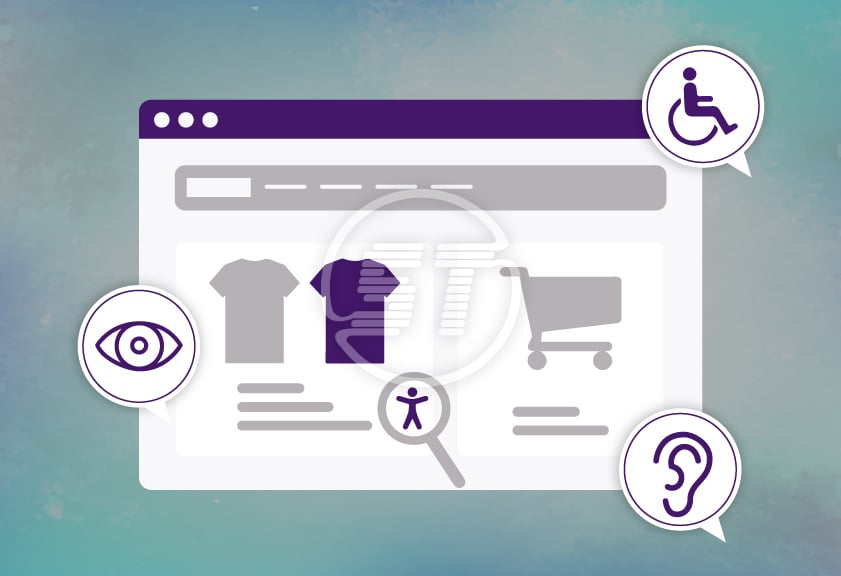In this digital era, ecommerce websites have become a major channel for shopping, making it crucial to ensure that these platforms are accessible to everyone, including people relying on screen readers.
Screen readers are essential tools that convert text to speech or Braille, enabling visually impaired users to navigate websites. To provide an inclusive shopping experience, ecommerce businesses must implement accessibility features that support screen reader functionality. Read along to learn more!
Strategies to enhance ecommerce accessibility for screen reader users!
Implement semantic HTML
Semantic HTML involves using HTML elements that convey the meaning and structure of content, making it easier for screen readers to interpret the website. This includes:
Proper use of headings: Using <h1>, <h2>, <h3>, etc., in a logical order helps screen readers understand the page’s structure and allows users to navigate sections quickly.
Correct use of lists: Utilize ordered (<o1>) and unordered (<u1>) lists appropriately to provide structure.
Descriptive form labels: Each form element, such as text fields or checkboxes, should have a
Use ARIA (Accessible Rich Internet Applications)
ARIA landmarks and roles define different parts of a webpage and improve the way screen readers interact with dynamic content. Developers can enhance the accessibility of dynamic and interactive content by using ARIA landmarks, roles, and properties. Some best ARIA practices include:
ARIA roles: Use roles like navigation, main, and complementary to identify sections of the webpage.
Live regions: Mark certain areas of the page as “live” to alert screen reader users of dynamic updates (for example: pop-ups, notifications, or live chat messages).
ARIA labels: Use ARIA labels to provide additional context for buttons, links, and interactive elements.
Ensure proper use of alt text for images
Alternative text (alt text) is crucial for images because it allows screen readers to describe the content of images to visually impaired users. Proper use of alt text ensures that screen reader users receive the same information as sighted users. To make alt text effective:
Descriptive alt text: Ensure the alt text accurately describes the content and purpose of the image. For example, “White tote bag with pink flowers” instead of “image1.jpg”.
Avoid redundancy: If an image is purely decorative and adds no value, consider using an empty alt attribute (alt=””) to avoid unnecessary distractions for screen reader users.
Informative text for product images: For ecommerce sites, product images should have detailed descriptions that convey important details, such as color, size, and unique features.
Provide accessible forms
Forms are a critical part of ecommerce, especially for tasks like checkout or account registration. By optimizing forms for screen reader accessibility, businesses can help all users complete important tasks without difficulty. Making forms accessible involves:
Descriptive labels and instructions: Ensure every form element has a label that describes its purpose. Use placeholder text as a supplement, not a replacement for labels.
Error handling and validation: Display error messages near the form fields where errors occur and describe how to correct them. Use ARIA attributes like aria-invalid to help screen readers identify errors.
Keyboard navigation: Ensure that form elements can be navigated using the keyboard, as many screen reader users rely on keyboard-only navigation.
Optimize keyboard navigation
Keyboard accessibility is fundamental for screen reader users to navigate using keyboard shortcuts instead of a mouse. Enhanced keyboard navigation makes the shopping experience more seamless and efficient for screen reader users. To improve keyboard navigation:
Logical tab order: Arrange interactive elements in a logical order to ensure smooth navigation through the site.
Focus indicators: Provide clear visual and auditory cues for elements currently in focus, so users know where they are on the page.
Skip navigation links: Include a “skip to main content” link to help users bypass repetitive content like navigation menus.
Label interactive elements clearly
Interactive elements such as buttons, links, and icons should be labeled in a way that conveys their purpose. Clear labeling helps users understand the functionality of various elements and reduces confusion:
Descriptive button text: Use labels like “Add to Cart” instead of “Submit” to clearly communicate the action.
Label all icons: Ensure that icons, such as social media links or functional elements (for example: search, cart), are labeled with descriptive text.
Use ARIA attributes for complex elements: For components like sliders or accordions, use ARIA attributes to convey their state (for example: expanded/collapsed) to screen readers.
Test with screen readers regularly
To ensure the site’s accessibility efforts are effective, it’s crucial to test with actual screen reader software. Popular screen readers include:
JAWS (Job Access With Speech)
NVDA (NonVisual Desktop Access)
VoiceOver (Mac and iOS)
TalkBack (Android)
Testing with these tools can reveal issues that automated accessibility checkers may miss. Consider involving people dependent on the screen readers to provide real-world feedback.
Ensure color contrast and text readability
While screen readers do not depend on visual elements, some users with low vision use screen readers in conjunction with other assistive tools. Enhancing readability through color contrast and text settings involves:
High Contrast Text: Maintain a minimum contrast ratio of 4.5:1 for normal text and 3:1 for large text. Leverage a WCAG Color Contrast Checker to verify that your website's text meets accessibility standards for contrast ratio.
Resizable text: Allow users to increase font size without breaking the layout.
Avoid color-dependent instructions: Do not rely solely on color to convey information, as some users may not perceive it correctly.
These practices help accommodate screen reader users with varying degrees of visual impairment.
Provide accessible PDF and other documents
If an ecommerce site offers downloadable content like user guides, product manuals, or reports, ensure these documents are also accessible. Accessible documents ensure that all users, regardless of disability, can engage with the content:
Use structured headings: Organize the document with headings to create a logical reading order.
Add alt text to images: Include descriptive alt text for images within the document.
Ensure compatibility with screen readers: Verify that the document is screen reader-compatible by testing with accessible PDF tools.
Stay informed and compliant with accessibility standards
Ecommerce websites must comply with accessibility guidelines like the Web Content Accessibility Guidelines (WCAG). Following recognized standards ensures a consistent, accessible experience for screen reader users and helps avoid legal issues related to non-compliance. These standards provide best practices to ensure websites are usable for people with disabilities:
Adhere to WCAG 2.1 standards: Aim for Level AA compliance to cover most accessibility needs.
Stay updated on new standards: Accessibility standards evolve, so it’s important to stay informed about changes or updates.
Regular audit: Conduct periodic accessibility audits to identify and fix any new issues that may arise.
In a nutshell,
Enhancing ecommerce accessibility for screen reader users requires a combination of technical strategies and ongoing commitment to inclusive design. By implementing semantic HTML, optimizing keyboard navigation, using ARIA landmarks, providing descriptive alt text, and adhering to accessibility standards, ecommerce websites can deliver a more user-friendly experience for all.
Investing in accessibility not only broadens the customer base but also ensures that all users, regardless of their abilities, can shop with ease and confidence. So, embrace accessibility this festive season and provide a welcoming ecommerce experience to everyone!
Ready to enhance your ecommerce website accessibility for screen reader users? At Skynet Technologies, we specialize in full-service website accessibility solutions that create a seamless shopping experience for everyone. Explore our expert strategies and take the first step towards an inclusive ecommerce platform. Reach out [email protected] to learn how we can help to enhance your website’s accessibility and reach a wider audience!


